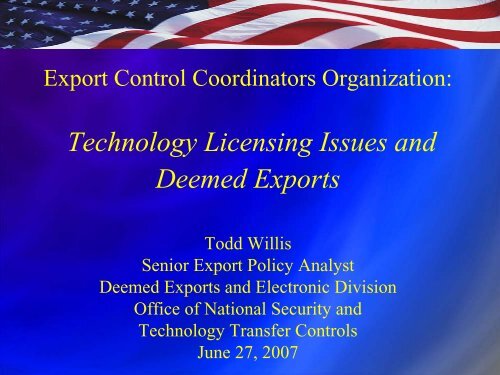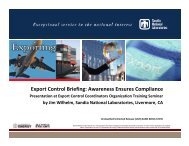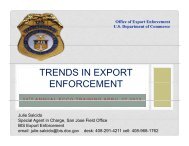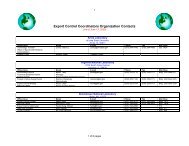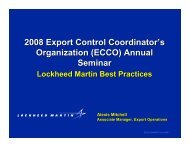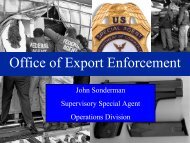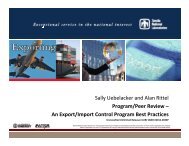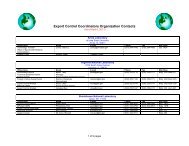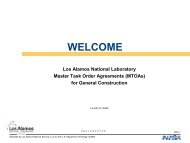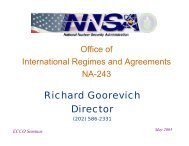Deemed Exports - Acquisition Services Management
Deemed Exports - Acquisition Services Management
Deemed Exports - Acquisition Services Management
Create successful ePaper yourself
Turn your PDF publications into a flip-book with our unique Google optimized e-Paper software.
Export Control Coordinators Organization:Technology Licensing Issues and<strong>Deemed</strong> <strong>Exports</strong>Todd WillisSenior Export Policy Analyst<strong>Deemed</strong> <strong>Exports</strong> and Electronic DivisionOffice of National Security andTechnology Transfer ControlsJune 27, 2007
Agenda• <strong>Deemed</strong> export year in review- Trends- Withdrawal of Advanced Notice of Proposed Rulemaking• “Use” technology• Country of origin licensing policy• Export controls in the context of fundamental research- <strong>Deemed</strong> Export Advisory Committee• <strong>Deemed</strong> export topic du jour• Technology Control Plan (TCPs):• Export Enforcement cooperation
<strong>Deemed</strong> Export Year in Review• <strong>Deemed</strong> export staffing doubled from three to six fulltime employees• BIS published two deemed export related FederalRegister Notices• Established the <strong>Deemed</strong> Export Advisory Committee• Maintained robust deemed export outreach programconducting over 120 outreach events
<strong>Deemed</strong> Export Year-End Summary• The deemed export program remains an important mechanismto prevent the diversion of sensitive dual use technologies tocountries and end users of concern• In FY2006, the Bureau approved 85%, returned without actionapproximately 14%, and denied less than 1% of the total of 830deemed export license applications• Almost 60% of the deemed export licenses processed are forPRC foreign nationals• Followed in descending order by foreign nationals from India(13%), Iran (7%), Russia and Germany (2%) and UK (1%)• Most deemed export licenses are processed in 40 days
Annual <strong>Deemed</strong> Export Licensing TrendsNumber of cases closed120010008006004002000TOTALAPPROVEDREJECTED995RWA'd976846 864865 840777749706707592632110125115 13360714 9 6 4 1 3FY 02 FY 03 FY 04 FY05 FY06 FY07*Days100808760624042 40 40 42200FY 02 FY 03 FY 04 FY05 FY06 FY07*** Projected** To DateMost Common <strong>Deemed</strong> <strong>Exports</strong>:• Semiconductor & Electronics - Category 3• High Performance Computers - Category 4• Telecommunications - Category 5
Recent Debate Over <strong>Deemed</strong> Export Policy• 2004: Commerce Office of Inspector General (OIG) Report– Highly critical of the <strong>Deemed</strong> Export Program• 2005: BIS published two deemed export related Federal RegisterNotices:– Establishment of Advisory Committee and Clarification of<strong>Deemed</strong> Export-Related Regulatory Requirements(71FR29301 of 05/22/06)– Withdrawal of the <strong>Deemed</strong> Export Advanced Notice ofProposed Rulemaking (71FR30840 of 05/31/06)• 2006-2007: <strong>Deemed</strong> Export Advisory Committee deliberations
Clarification of “Use” Technology• The use of export controlled equipment is not a deemed export. <strong>Deemed</strong> exportsoccur only if controlled technology is transferred.• The regulatory definition of “use” is technology for “operation, installation(including on-site installation), maintenance (checking), repair, overhaul andrefurbishing.”• General Technology Note:– The term “technology” as used in the EAR refers to specific information “required” forthe “development,” “production,” or “use” of specific product (e.g. computer, fermenter,machine tool, etc.).– “Required” technology refers only to that portion of technology which is peculiarlyresponsible for achieving or exceeding controlled performance levels, characteristics orfunctions.• Controlled “use” technology requires all six attributes of the definition in order toqualify as controlled “use” technology. Otherwise the technology is likely EAR99.
Reaffirmation of Foreign National Licensing Policy• Naturalized U.S. citizens, U.S. Legal Permanent Residents and U.S. Asylees andRefugees are protected individuals and are not subject to the deemed export rule.• <strong>Deemed</strong> export licensing policy for foreign nationals that are not protectedindividuals (i.e., third country nationals) is based on recently established legalpermanent residence or citizenship.– For example: A foreign national born in Iran that has established citizenship orpermanent residency in Canada would be treated for licensing purposes as aCanadian.• If an exporter is unable to determine a foreign national’s country of origin fordeemed export licensing, the exporter should consult with BIS.• For deemed reexports to a foreign national of another country, licensing is alsobased on the foreign national’s recently established permanent residency orcitizenship.
Scope of Fundamental Research Is Unchanged• “Fundamental research is basic and applied research in science andengineering where the resulting information is ordinarily publishedand shared broadly within the scientific community.” (EAR Part734.8)• "While the product of the fundamental research is not subject to theEAR because the results of that research are intended forpublication and dissemination within the scientific community,authorization may be required if during the conduct of theresearch controlled technology is released to a foreignnational.“(71FR30840 of 05/31/06)
Scope of Fundamental Research Is Unchanged• Fundamental research technology is not subject to the EARbecause:– the technology that rises during or results from the research is normallymade public; and,– the technology necessary to conduct the research is normally obtained frompublic or published sources.• If preexisting technology necessary to conduct the research isexport controlled; or, if a researcher makes a decision to control thetechnology that results from the research, then, deemed exportlicensing requirements must be considered.
<strong>Deemed</strong> Export Advisory Committee• Comprehensive policy review• Required by law to meet quarterly• Meetings open to the public• The final report is expected to be delivered to theSecretary of Commerce in late 2007
<strong>Deemed</strong> Export Advisory Committee• DEAC Members– Norman Augustine, Retired Chairman & CEO, Lockheed Martin Corporation*;– Robert Gates, PhD, President of Texas A&M University**– Albert Carnesale, PhD, Former Chancellor of the University of California at Los Angeles;– Ruth David, PhD, President & CEO, Analytic <strong>Services</strong>, Inc.;– The Honorable John Engler, President, National Association of Manufacturers;– Anthony Frank, PhD, Provost and Senior Vice President, Colorado State University;– General John A. Gordon, Former Deputy Director, Central Intelligence Agency;– Sean O'Keefe, Chancellor, Louisiana State University;– Eva Pell, PhD, Senior Vice President and Dean of the Graduate School, Penn StateUniversity;– Michael Splinter, CEO, Applied Materials;– James Siedow, PhD, Vice Provost for Research and Professor of Biology, DukeUniversity;– William A. Wulf, PhD, President, National Academy of Engineering and Professor ofComputer Science and University Professor, University of Virginia.* Chairperson ** Resigned to become Secretary of Defense
<strong>Deemed</strong> Export Control Topic Du Jour• Exporters must distinguish between the following toinsure the correct licensing authorization:• <strong>Deemed</strong> export of technology;• <strong>Deemed</strong> reexport of technology;• Technology export; and,• Technology reexport.• Exporters in general are creating unnecessary licensingburdens for themselves.
Distinguishing <strong>Deemed</strong> Export from TechnologyExport• A deemed export is the release of controlled technology or sourcecode to a foreign national in the U.S.• A technology export is the release of controlled technology in aforeign country• <strong>Deemed</strong> export licensing authorization is based on a review of theindividual foreign national’s background, country of origin and levelof technology• Technology export licensing authorization is based on the ultimateconsignee’s country, the level of technology and the bonafides ofthe consignee• BIS does not license individual employees of consignees on atechnology export license
Distinguishing <strong>Deemed</strong> Reexport from TechnologyReexport• A deemed reexport is the release of controlled technology or source code to aforeign national of another country; this is deemed to be a reexport to theforeign national’s home country• In many cases technology exported to the country home of that foreign nationalmay be exported NLR or under License Exception (LE) not available for theforeign national’s home country• e.g., ECCN 5E001 technology may be exported to a company in Irelandunder LE TSR.• A Russian foreign national employee of that company in Ireland requiresdeemed reexport license authorization to receive this technology• A technology reexport is the actual shipment or transmission of controlledtechnology from one foreign country to another foreign country
Considerations to Ease Licensing Burden• If a consignee on a technology export license intends to send employees to theU.S. for training or other requirements resulting in the need for controlledtechnology, identify this on the export license application• A duplicative deemed export license is not required• If your company has multiple subsidiaries in different countries, technologyexport authorization could authorize reexports as well• Exporters need to specify these requirements in its application• This could also authorize deemed reexport requirements for employees ofthe company’s foreign subsidiaries visiting its other foreign subsidiaries• A technology export license does not require information on individualemployees
Developing a Technology Control Plan (TCP)• The requirement for a TCP is a standard condition of approval for adeemed export license• A TCP should include the following six essential elements:- Corporate commitment to export compliance- Physical security plan- Information security plan- Personnel screening procedures- Training and awareness program- Self evaluation program
Essential Elements of a TCP1. Corporate commitment to export compliance• Organizational chain of command of export complianceteam• Must have member of senior management teamresponsible for export compliance• Demonstrate how compliance issues are resolved• Show evidence of methodology for commodityclassification of technology in the workplace• Top-down leadership (e.g., CEO company wide letter thatestablishes a corporate culture of export compliance)
Essential Elements of a TCP2. Physical security plan:• Structure of building security at each technologylocation• Description of physical security plan (badge access,secure door access…).• Perimeter security and access control.
Essential Elements of a TCP3. Information security plan:• Command structure of IT security at each technologylocation• Description of IT security plan (password access,firewall protection plans…)• Verification of technology authorization (terminatedemployees, individuals working on new projects…)• Intranet and internet security
Essential Elements of a TCP4. Personnel screening procedures:• At minimum must review entities and denied partieslist.• What types of background checks are conducted(criminal, drivers license, credit…).• Must know procedures that 3rd party contractors use(e.g. temporary employment agencies)• Non-disclosure agreements
Essential Elements of a TCP5. Training and awareness program:• Schedule of training program for informing foreignnational employee of technology access limits• Description of training for U.S. employees which haveaccess to controlled technology areas• Export control awareness training for all employees
Essential Elements of a TCP6. Self evaluation program:• Self auditing schedule• Checklist of items reviewed during each audit• Action item and corrective procedures• Internal or external audit
TCP Summary• There is no one-size-fits-all• Necessary to provide assurance that information will notbe diverted to foreign national’s home country• Typical agenda item for BIS site visit• Verification of TCP effectiveness is a goal of domestic postshipment verification/pre-license check to assurecompliance with license conditions20
Export Enforcement Role in <strong>Deemed</strong> <strong>Exports</strong>:<strong>Deemed</strong> Export Domestic PSV Program• Joint EE/EA Program: <strong>Deemed</strong> exportcompliance program designed to determine:– Compliance with license conditions– Deviations from the scope of license– Compliance with the Technology Control Plan (TCP)– Possible unauthorized releases of controlled technologyto the foreign national or unauthorized foreign nationals
Export Enforcement Role in <strong>Deemed</strong> <strong>Exports</strong>:<strong>Deemed</strong> Export Domestic PSV Program• Spans all Commerce Control List categories• 2006: EE /EA conducted 10 domestic PSVs• 2007: Plans to conduct an additional 10-15 PSVs– License holders have demonstrated a high degree ofcompliance• Preparing for domestic PSV: Internal compliance assessment• EE continues to review selected licenses based on certain riskfactors & conduct domestic PSVs as necessary
BIS Web sitewww.bis.doc.gov• Licensing– <strong>Deemed</strong> <strong>Exports</strong>• Process Improvements• Licensing Guidance• Frequently Asked Questions• Q&A’s on Clarification of <strong>Deemed</strong> Export RegulatoryRequirements
<strong>Deemed</strong> Export ContactsAlexander LopesDirector, <strong>Deemed</strong> <strong>Exports</strong> andElectronics DivisionPh: 202-482- 4875E-mail: alopes@bis.doc.govTodd WillisSenior Export Policy AnalystPh: 202-482-9163E-mail: twillis@bis.doc.govKurt FranzSenior Export Policy AnalystPh: 202-482-2278E-mail: kfranz@bis.doc.govIlona ShtromSenior Export Policy AnalystPh: 202-482-3235E-mail: lshtrom@bis.doc.govRobert JusteSenior Electrical EngineerPh: 202-482-8245E-mail: rjuste@bis.doc.gov


